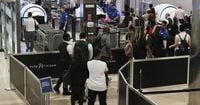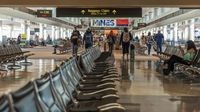After weeks of turbulence caused by the longest government shutdown in U.S. history, the nation’s skies are finally clearing. On Monday, November 17, 2025, the Federal Aviation Administration (FAA) announced that flights across the United States would return to normal schedules, effective from 6:00 am Washington time (1100 GMT). This long-awaited decision comes after a record 43-day government shutdown that left thousands of flights canceled, millions of passengers stranded, and the entire travel industry on edge as the busy holiday season approached.
The shutdown, which ended on Wednesday, November 12, 2025, with President Donald Trump signing a bill to reopen the government, had far-reaching effects on both travelers and the aviation sector. According to AFP, ten percent of domestic flights were cut at 40 of the busiest U.S. airports due to a severe shortage of air traffic control staff. These professionals were asked to work without pay as the budget stalemate dragged on, leading many to call in sick or simply not show up for their shifts. The result? Widespread delays, cancellations, and a deep sense of uncertainty for anyone hoping to fly.
The FAA had been forced to issue an emergency order, incrementally reducing flights by up to 10% at key airports, as reported by CNN. Even after the shutdown officially ended, some flight reductions lingered—over the weekend before November 17, flights were still down by 3%. The Department of Transportation confirmed that as of November 12, FAA-mandated cuts were frozen at 6% until it was deemed safe to resume full operations. But now, with the restrictions lifted, the agency says "normal operations can resume" nationwide.
Transport Secretary Sean Duffy signaled a new chapter for the industry, stating, "Now we can refocus our efforts on surging controller hiring and building the brand new, state-of-the-art air traffic control system." He added, "The FAA safety team is encouraged to see our air traffic control staffing surge, and they feel comfortable with pausing the reduction schedule to give us time to review the airspace. If the FAA safety team determines the trend lines are moving in the right direction, we’ll put forward a path to resume normal operations."
For the major airlines—American, United, Delta, and Southwest—the lifting of restrictions is a lifeline. According to a detailed industry update, all four carriers are cleared to resume their full schedules, including vital domestic and international routes. American Airlines immediately reinstated flights to destinations such as London, Paris, and Mexico City, while Delta and United also ramped up their networks. Southwest, a key player in domestic travel, confirmed a full return to service to meet the anticipated surge in holiday demand.
This move couldn’t come at a better time. The Thanksgiving holiday, falling on November 27 this year, is always one of the busiest travel periods in the U.S. Airlines for America, the industry’s main trade group, expects a record 31 million passengers to take to the skies over the holiday period. Ed Bastian, CEO of Delta Air Lines, reassured nervous travelers in an interview with CNBC, stating, "Thanksgiving will be fine." Chris Sununu, president and CEO of Airlines for America, echoed this optimism, noting, "We are preparing for record Thanksgiving travel, with some 31 million passengers expected, and the busy shipping season is coming up. However, airlines cannot flip a switch and resume normal operations immediately after a vote—there will be residual effects for days."
The shutdown’s impact was not limited to the air. According to Reuters and travel analytics firm Cirium, while holiday flight bookings were up 2.2% at the end of October compared to last year, reservations slowed after the first week of November as travelers grew wary of cancellations and delays. Many Americans, anxious about the state of air travel, looked for alternatives. Bus and train travel saw a 12% increase over last year, with companies like Amtrak, Megabus, and FlixBus reporting spikes in bookings. Kai Boysan, CEO of Flix North America, told Reuters, "More travelers may turn to ground transportation in the days ahead," and companies were prepared to add capacity as needed.
Despite the return to normalcy, some travel experts caution that the aftershocks of the shutdown may linger. Katy Nastro, a travel analyst with Going.com, warned, "If we are still down a certain number of controllers … we may see disruptions into Thanksgiving, yet likely not to this extent." The FAA itself acknowledged ongoing staffing shortages, which predated the shutdown. While the immediate crisis has passed, the agency and airlines must now accelerate hiring and training to ensure the system is robust enough to handle future surges in demand.
Another concern for travelers is the cost of flying. According to Going.com, domestic flight prices are expected to be 6% higher during Thanksgiving week compared to last year, with a further 7% increase projected for Christmas and New Year. While airlines have not commented directly on the causes, it’s clear that the recent reductions in flight capacity and the pent-up demand for holiday travel are playing a role. For many families hoping to reunite for the holidays, the combination of higher prices and recent travel chaos is a tough pill to swallow.
The broader tourism and hospitality industries are also watching closely. The return to full flight schedules is expected to boost hotel bookings and visitor numbers in major destinations like New York, Orlando, and Las Vegas. As international visitors regain confidence in U.S. travel, cities that rely on tourism dollars are likely to see a welcome uptick in business. Hotels, restaurants, and attractions that suffered during the shutdown are preparing for a busy season, but they too are mindful of the need for flexibility as the industry works through the backlog of disruptions.
In the end, the lifting of FAA restrictions marks a turning point for U.S. air travel after one of its most challenging periods in recent memory. With airlines resuming regular operations and travelers regaining some sense of certainty, the stage is set for a holiday season that—while not entirely free of bumps—offers hope for smoother journeys ahead. The focus now shifts to rebuilding the air traffic control workforce and modernizing the nation’s aviation infrastructure, ensuring that the lessons of this historic shutdown lead to a more resilient system in the future.


